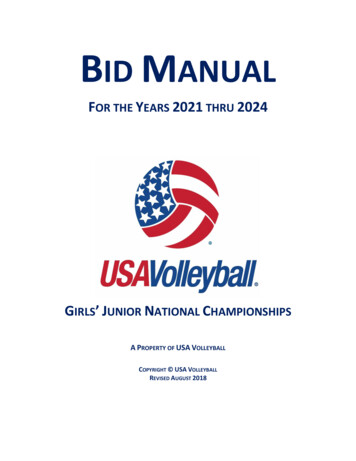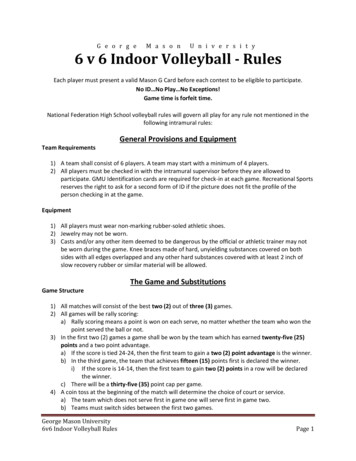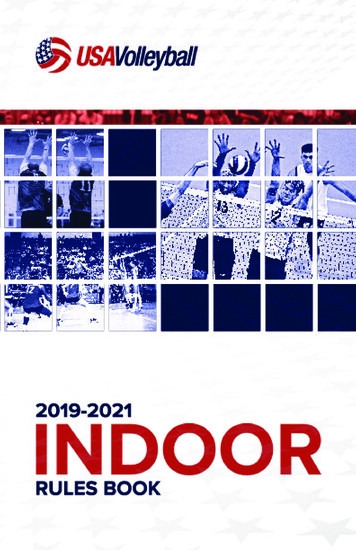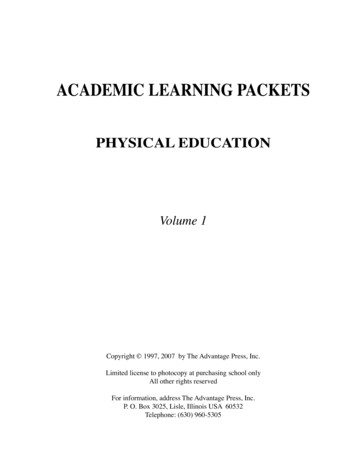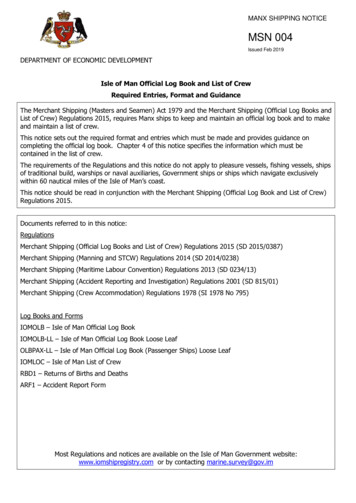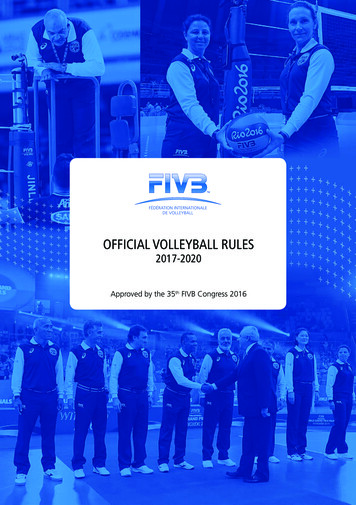
Transcription
OFFICIAL VOLLEYBALL RULES2017-2020Approved by the 35th FIVB Congress 2016
Official Volleyball Rules 2017-2020Published by FIVB in 2016 – www.fivb.comDesign and layout: Samuel ChesauxIllustrations: FIVB 2014
OFFICIAL VOLLEYBALL RULES2017-2020Approved by the 35th FIVB Congress 2016To be implemented in all competitions beginning after 1st January 2017OFFICIAL VOLLEYBALL RULES 2017-20201
CONTENTSGAME CHARACTERISTICS7PART 1: PHILOSOPHY OF RULES AND REFEREEING8PART 2 - SECTION 1: GAME11CHAPTER 1: FACILITIES AND EQUIPMENT12123PLAYING AREA.121.1DIMENSIONS.121.2PLAYING SURFACE.121.3LINES ON THE COURT.131.4ZONES AND AREAS.131.5TEMPERATURE.141.6LIGHTING.14NET AND POSTS.142.1HEIGHT OF THE NET.142.2STRUCTURE.152.3SIDE BANDS.152.4ANTENNAE.152.5POSTS.152.6ADDITIONAL EQUIPMENT.16BALLS.163.1STANDARDS.163.2UNIFORMITY OF BALLS.163.3FIVE-BALL SYSTEM.16CHAPTER 2: PARTICIPANTS45217TEAMS.174.1TEAM COMPOSITION.174.2LOCATION OF THE TEAM.184.3EQUIPMENT.184.4CHANGE OF EQUIPMENT.194.5FORBIDDEN OBJECTS.19TEAM LEADERS.195.1CAPTAIN.195.2COACH.205.3ASSISTANT COACH.21
CHAPTER 3: PLAYING FORMAT67TO SCORE A POINT, TO WIN A SET AND THE MATCH.226.1TO SCORE A POINT.226.2TO WIN A SET.226.3TO WIN THE MATCH.236.4DEFAULT AND INCOMPLETE TEAM.23STRUCTURE OF PLAY.237.1THE TOSS.237.2OFFICIAL WARM-UP SESSION.237.3TEAM STARTING LINE-UP.247.4POSITIONS.257.5POSITIONAL FAULT.257.6ROTATION.267.7ROTATIONAL FAULT.26CHAPTER 4: PLAYING ACTIONS892227STATES OF PLAY.278.1BALL IN PLAY.278.2BALL OUT OF PLAY.278.3BALL “IN”.278.4BALL “OUT”.27PLAYING THE BALL. 289.1TEAM HITS.289.2CHARACTERISTICS OF THE HIT.289.3FAULTS IN PLAYING THE BALL.2910 BALL AT THE NET.2910.1 BALL CROSSING THE NET.2910.2 BALL TOUCHING THE NET.3010.3 BALL IN THE NET.3011 PLAYER AT THE NET.3011.1 REACHING BEYOND THE NET.3011.2 PENETRATION UNDER THE NET.3011.3 CONTACT WITH THE NET.3111.4 PLAYER’S FAULTS AT THE NET.3112 SERVICE.3112.1 FIRST SERVICE IN A SET.3112.2 SERVICE ORDER.3212.3 AUTHORIZATION OF THE SERVICE.3212.4 EXECUTION OF THE SERVICE.32OFFICIAL VOLLEYBALL RULES 2017-20203
12.5 SCREENING.3212.6 FAULTS MADE DURING THE SERVICE.3312.7 SERVING FAULTS AND POSITIONAL FAULTS.3313 ATTACK HIT.3313.1 CHARACTERISTICS OF THE ATTACK HIT.3313.2 RESTRICTIONS OF THE ATTACK HIT.3313.3 FAULTS OF THE ATTACK HIT.3414 BLOCK.3414.1 BLOCKING.3414.2 BLOCK CONTACT.3514.3 BLOCKING WITHIN THE OPPONENT’S SPACE.3514.4 BLOCK AND TEAM HITS.3514.5 BLOCKING THE SERVICE.3514.6 BLOCKING FAULTS.35CHAPTER 5: INTERRUPTIONS, DELAYS AND INTERVALS3615 INTERRUPTIONS.3615.1 NUMBER OF REGULAR GAME INTERRUPTIONS.3615.2 SEQUENCE OF REGULAR GAME INTERRUPTIONS.3615.3 REQUEST FOR REGULAR GAME INTERRUPTIONS.3615.4 TIME-OUTS AND TECHNICAL TIME-OUTS.3715.5 SUBSTITUTION.3715.6 LIMITATION OF SUBSTITUTIONS.3715.7 EXCEPTIONAL SUBSTITUTION.3715.8 SUBSTITUTION FOR EXPULSION OR DISQUALIFICATION.3815.9 ILLEGAL SUBSTITUTION.3815.10 SUBSTITUTION PROCEDURE.3815.11 IMPROPER REQUESTS.3916 GAME DELAYS.3916.1 TYPES OF DELAYS.3916.2 DELAY SANCTIONS.4017 EXCEPTIONAL GAME INTERRUPTIONS. 4017.1 INJURY / ILLNESS.4017.2 EXTERNAL INTERFERENCE.4017.3 PROLONGED INTERRUPTIONS.4018 INTERVALS AND CHANGE OF COURTS.4118.1 INTERVALS.4118.2 CHANGE OF COURTS.414
CHAPTER 6: THE LIBERO PLAYER4219 THE LIBERO PLAYER.4219.1 DESIGNATION OF THE LIBERO.4219.2 EQUIPMENT.4219.3 ACTIONS INVOLVING THE LIBERO.4219.4 RE-DESIGNATION OF A NEW LIBERO.4419.5 SUMMARY.45CHAPTER 7: PARTICIPANTS’ CONDUCT4620 REQUIREMENTS OF CONDUCT.4620.1 SPORTSMANLIKE CONDUCT.4620.2 FAIR PLAY.4621 MISCONDUCT AND ITS SANCTIONS.4621.1 MINOR MISCONDUCT.4621.2 MISCONDUCT LEADING TO SANCTIONS.4721.3 SANCTION SCALE.4721.4 APPLICATION OF MISCONDUCT SANCTIONS.4821.5 MISCONDUCT BEFORE AND BETWEEN SETS.4821.6 SUMMARY OF MISCONDUCT AND CARDS USED.48PART 2 - SECTION 2: THE REFEREES, THEIR RESPONSIBILITIES AND OFFICIAL HAND SIGNALS49CHAPTER 8: REFEREES5022 REFEREEING CORPS AND PROCEDURES.5022.1 COMPOSITION.5022.2 PROCEDURES.5023 1st REFEREE.5123.1 LOCATION.5123.2 AUTHORITY.5123.3 RESPONSIBILITIES.5224 2nd REFEREE.5324.1 LOCATION.5324.2 AUTHORITY.5324.3 RESPONSIBILITIES.5425 SCORER.5525.1 LOCATION.5525.2 RESPONSIBILITIES.55OFFICIAL VOLLEYBALL RULES 2017-20205
26 ASSISTANT SCORER.5626.1 LOCATION.5626.2 RESPONSIBILITIES.5627 LINE JUDGES.5727.1 LOCATION.5727.2 RESPONSIBILITIES.5728 OFFICIAL SIGNALS.5828.1 REFEREES’ HAND SIGNALS.5828.2 LINE JUDGES’ FLAG SIGNALS.58PART 2 - SECTION 3: DIAGRAMS59D1a COMPETITION / CONTROL AREA.60D1b THE PLAYING AREA.61D2THE PLAYING COURT.62D3DESIGN OF THE NET.63D4POSITION OF PLAYERS.64D5a BALL CROSSING THE VERTICAL PLANE OF THE NET TO THE OPPONENT COURT.65D5b BALL CROSSING THE VERTICAL PLANE TO THE OPPONENT FREE ZONE.66D6COLLECTIVE SCREEN.67D7COMPLETED BLOCK.67D8BACK ROW PLAYER’S ATTACK.68D9WARNINGS AND SANCTIONS SCALES AND THEIR CONSEQUENCES.69D9a MISCONDUCT WARNINGS AND SANCTIONS.69D9b DELAY WARNINGS AND SANCTIONS.69D10 LOCATION OF THE REFEREEING CORPS AND THEIR ASSISTANTS.70D11 REFEREES’ OFFICIAL HAND SIGNALS.71-77D12 LINE JUDGES’ OFFICIAL FLAG SIGNALS.78-796PART 3: DEFINITIONS80INDEX83
GAME CHARACTERISTICSVolleyball is a sport played by two teams on a playing court divided by a net.There are different versions available for specific circumstances in order tooffer the versatility of the game to everyone.The object of the game is to send the ball over the net in order to ground it onthe opponent’s court, and to prevent the same effort by the opponent. Theteam has three hits for returning the ball (in addition to the block contact).The ball is put in play with a service: hit by the server over the net to theopponents. The rally continues until the ball is grounded on the playing court,goes “out” or a team fails to return it properly.In Volleyball, the team winning a rally scores a point (Rally Point System).When the receiving team wins a rally, it gains a point and the right to serve,and its players rotate one position clockwise.OFFICIAL VOLLEYBALL RULES 2017-20207
PART 1PHILOSOPHY OF RULESAND REFEREEING8
PART 1: PHILOSOPHY OF RULES AND REFEREEINGINTRODUCTIONVolleyball is one of the most successful and popular competitive and recreational sports in theworld. It is fast, it is exciting and the action is explosive. Yet Volleyball comprises several crucialoverlapping elements whose complimentary interactions render it unique amongst rally umping PowerAttackTEAM GAMEDIVIDEDCOURTSDefenseIn recent years the FIVB has made great strides in adapting the game to a modern audience.This text is aimed at a broad Volleyball public – players, coaches, referees, spectators, commentators –for the following reasons:–– understanding the rules better, allows better play – coaches can create better team structure andtactics, allowing players full rein to display their skills;–– understanding the relationship between rules allows officials to make better decisions.This introduction at first focuses on Volleyball as a competitive sport, before setting out to identifythe main qualities required for successful refereeing.VOLLEYBALL IS A COMPETITIVE SPORTCompetition taps latent strengths. It exhibits the best of ability, spirit, creativity and aesthetics.The rules are structured to allow all of these qualities. With a few exceptions, Volleyball allowsall players to operate both at the net (in attack) and in the back of the court (to defend or serve).William Morgan, the game’s creator, would still recognize it because Volleyball has retained certaindistinctive and essential elements over the years. Some of these it shares with other net/ball/racquet games:–– Service–– Rotation (taking turns to serve)–– Attack–– DefenseVolleyball is, however, unique amongst net games in insisting that the ball is in constant flight– a flying ball – and by allowing each team a degree of internal passing before the ball must bereturned to the opponents.The introduction of a specialist defensive player – the Libero – has moved the game forward inOFFICIAL VOLLEYBALL RULES 2017-20209
terms of rally length and multi-phase play. Modifications to the service rule have changed the actof service from simply a means of putting the ball in play to an offensive weapon.The concept of rotation is entrenched to allow for all-round athletes. The rules on player positionsmust permit teams to have flexibility and to create interesting developments in tactics.Competitors use this framework to contest techniques, tactics and power. The framework alsoallows players a freedom of expression to enthuse spectators and viewers.And the image of Volleyball is increasingly a good one.THE REFEREE WITHIN THIS FRAMEWORKThe essence of a good official lies in the concept of fairness and consistency:–– to be fair to every participant,–– to be viewed as fair by the spectators.This demands a huge element of trust – the referee must be trusted to allow the players to entertain:–– by being accurate in his/her judgement;–– by understanding why the rule is written;–– by being an efficient organizer;–– by allowing the competition to flow and by directing it to a conclusion;–– by being an educator – using the rules to penalise the unfair or admonish the impolite;–– by promoting the game – that is, by allowing the spectacular elements in the game to shineand the best players to do what they do best: entertain the public.Finally we can say that a good referee will use the rules to make the competition a fulfillingexperience for all concerned.To those who have read thus far, view the rules which follow as the current state of development of agreat game, but keep in mind why these preceding few paragraphs may be of equal importance to youin your own position within the sport.Get involved !Keep the ball flying !10
PART 2SECTION 1: GAMEOFFICIAL VOLLEYBALL RULES 2017-202011
CHAPTER 1FACILITIES AND EQUIPMENTSee Rules11.1PLAYING AREAThe playing area includes the playing court and the free zone. It shall berectangular and symmetrical.1.1, D1a, D1bDIMENSIONSD2The playing court is a rectangle measuring 18 x 9 m, surrounded by afree zone which is a minimum of 3 m wide on all sides.The free playing space is the space above the playing area which is freefrom any obstructions. The free playing space shall measure a minimumof 7 m in height from the playing surface.For FIVB, World and Official Competitions, the free zone shallmeasure 5 m from the side lines and 6.5 m from the end lines. Thefree playing space shall measure a minimum of 12.5 m in heightfrom the playing surface.1.2PLAYING SURFACE1.2.1The surface must be flat, horizontal and uniform. It must not presentany danger of injury to the players. It is forbidden to play on rough orslippery surfaces.For FIVB, World and Official Competitions, only a wooden orsynthetic surface is allowed. Any surface must be previouslyapproved by the FIVB.1.2.21.2.312On indoor courts the surface of the playing court must be of a lightcolour.For FIVB, World and Official Competitions, white colours arerequired for the lines. Other colours, different from each other,are required for the playing court and the free zone.1.1, 1.3On outdoor courts a slope of 5 mm per metre is allowed for drainage.Court lines made of solid materials are forbidden.1.3
PART 2 - SECTION 1: GAME1.3LINES ON THE COURTD21.3.1All lines are 5 cm wide. They must be of a light colour which is differentfrom the colour of the floor and from any other lines.1.2.21.3.2Boundary linesTwo side lines and two end lines mark the playing court. Both side linesand end lines are drawn inside the dimensions of the playing court.1.3.3Centre lineThe axis of the centre line divides the playing court into two equalcourts measuring 9 x 9 m each; however the entire width of the line isconsidered to belong to both courts equally. This line extends beneaththe net from side line to side line.1.3.41.1D2Attack lineOn each court, an attack line, whose rear edge is drawn 3 m back fromthe axis of the centre line, marks the front zone.1.3.3, 1.4.1For FIVB, World and Official Competitions, the attack line isextended by the addition of broken lines from the side lines,with five 15 cm short lines 5 cm wide, drawn 20 cm from eachother to a total length of 1.75 m. The “coach’s restriction line” (abroken line which extends from the attack line to the end line ofthe court, parallel to the side line and 1.75 m from it) is composedof 15 cm short lines drawn 20 cm apart to mark the limit of thecoach’s area of operation.D21.4ZONES AND AREASD1b, D21.4.1Front zone19.3.1.4,23.3.2.3e, D2On each court the front zone is limited by the axis of the centre line andthe rear edge of the attack line.1.3.3, 1.3.4,19.3.1.4,23.3.2.3eThe front zone is considered to extend beyond the side lines to the endof the free zone.1.1, 1.3.21.4.2Service zoneThe service zone is a 9 m wide area behind each end line.It is laterally limited by two short lines, each 15 cm long, drawn 20 cmbehind the end line as an extension of the side lines. Both short lines areincluded in the width of the service zone.1.3.2, 12, D1bIn depth, the service zone extends to the end of the free zone.1.1OFFICIAL VOLLEYBALL RULES 2017-202013
1.4.3Substitution zoneThe substitution zone is limited by the extension of both attack lines upto the scorer's table.1.4.4Libero Replacement zoneThe Libero Replacement zone is part of the free zone on the side ofthe team benches, limited by the extension of the attack line up to theend line.1.4.524.2.5, D1a,D1bPenalty areaA penalty area, sized approximately 1 x 1 m and equipped with twochairs, is located in the control area, outside the prolongation of eachend line. They may be limited by a 5 cm wide red line.1.519.3.2.7, D1bWarm-up areaFor FIVB, World and Official Competitions, the warm-up areas,sized approximately 3 x 3 m, are located in both of the benchside corners, outside the free zone.1.4.61.3.4, 15.6.1,D1b21.3.2.1, D1a,D1bTEMPERATUREThe minimum temperature shall not be below 10 C (50 F).For FIVB, World and Official Competitions, the maximumtemperature shall not be higher than 25 C (77 F) and theminimum not lower than 16 C (61 F).1.614LIGHTINGFor FIVB, World and Official Competitions, the lighting on theplaying area should be 1000 to 1500 lux measured at 1 m abovethe surface of the playing area.12NET AND POSTSD32.1HEIGHT OF THE NET2.1.1Placed vertically over the centre line there is a net whose top is set at theheight of 2.43 m for men and 2.24 m for women.1.3.32.1.2Its height is measured from the centre of the playing court. The netheight (over the two side lines) must be exactly the same and must notexceed the official height by more than 2 cm.1.1, 1.3.2,2.1.1
PART 2 - SECTION 1: GAME2.2STRUCTUREThe net is 1 m wide and 9.50 to 10 m long (with 25 to 50 cm on eachside of the side bands), made of 10 cm square black mesh.D3For FIVB, World and Official Competitions, in conjunction withspecific competition regulations, the mesh may be modified tofacilitate advertising according to marketing agreements.At its top a horizontal band, 7 cm wide, made of two-fold white canvas,is sewn along its full length. Each extreme end of the band has a hole,through which passes a cord, fastening the band to the
The rules are structured to allow all of these qualities. With a few exceptions, Volleyball allows all players to operate both at the net (in attack) and in the back of the court (to defend or serve). Willi

